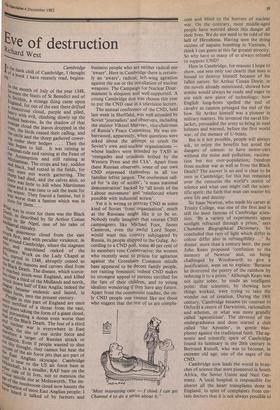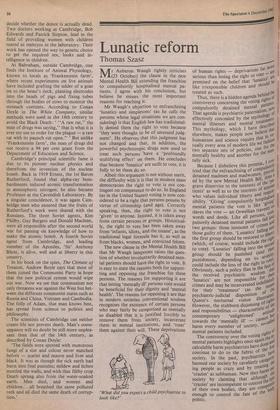ve of destruction
Cambridge Cambridge the dank chill of Cambridge, I thought
• elf a book I have recently read, beginn- ing: Ill the month of July of the year 1348, uetween the feasts of St Benedict and of , Swithin, a strange thing came upon England, for out of the east there drifted a Monstrous cloud, purple and piled, iheavy with evil, climbing slowly up the :',Iished heavens. In the shadow of that ,"range cloud the leaves dropped in the t`Lrees, the birds ceased their calling, and :ite cattle and the sheep gathered cower- '48 under their hedges .... Then the _aiti began to fall... It was raining at ;°11/1, Mas-tide and raining at the Feast of ,."te Assumption and still raining at michaelmas. The crops and hay, sodden arid black, had rotted in the fields, for 4,1_4 were not worth garnering. The Sheep had died, and the calves also, so here Was little to kill when Martinmas t-kaate and it was time to salt the meat for e Winter. They feared a famine, but it -as worse than a famine which was in store for them. What bea,k was in store for them was the Black as described by Sir Arthur Conan tti.',,Y!aevalSir Nigel, one of his tales of
'-1,iti chivalry.
strum' , Poisonous cloud from the east and first, and with peculiar virulence, in feri' around Cambridge, where the stagnant Dessti6 and marshland reeked of the
y
El,– nee. Work on the Lady Chapel at inus started in 1348, abruptly ceased as t of the to„ ,the Masons and carvers died from ly r "'etc Death. The disease, which scarce- le south-west England, and killed stril' than a third of the Midlands and north, PlaRenk down half of East Anglia; indeed the
lUIl became endemic and lasted, in
Pee,r ',oral, into the present century. ttiere"The in this part of England are once oac; terrified of a threat from the east, arid" more taking the form of a giant cloud, that Portending a doom even worse than alld of the Black Death. The fear of a third Ano.altelear war is everywhere in East
6.11a,
theref Ile site of our strike force and retarZe a target of Russian attack or t-i7t)u. Even if people wanted to shut ream
`uis tho
sc ught, they cannot but hear the the t of the air force jets that are part of ltstif'iast Anglian skyscape. Cambridge Mila,11ear to the US air force base at ()the–wall, to a smaller, RAF base on the erair Side f 0- St Ives, not to mention the ate se Missile site at Molesworth. The im- 14i: the mushroom cloud now haunts the have'll,_4tion of most East Anglian people: I
heard it talked of by farmers and business people who are neither radical nor 'aware'. Here in Cambridge there is certain- ly an 'aware', radical, left-wing agitation against the use or the installation of nuclear weapons. The Campaign for Nuclear Disar- mament is eloquent and well-supported. A young Cambridge don was chosen this year to put the CND case in a television lecture.
The annual conference of the CND, held last week in Sheffield, was well attended by Soviet 'journalists' and observers, including the sinister Vikenti Matveev, vice-chairman of Russia's Peace Committee. He was em- barrassed, apparently, when questions were asked about the attempt to crush the Soviet's own anti-nuclear organisations — whose leaders were branded by TASS as 'renegades and criminals bribed by the Western Press and the CIA'. Apart from these Russian observers, some of our own CND expressed themselves in all too familiar leftist jargon. The conference call- ed for 'a day of action', 'a mass national demonstration' backed by 'all levels of the Labour movement' and 'reinforced where possible with industrial action'.
Yet it is wrong to portray CND as some kind of Soviet 'front organisation', much as the Russians might like it to be so. Nobody really imagines that veteran CND campaigners like Michael Foot, James Cameron, even the awful Lord Soper, would want this country subjugated by Russia, its people shipped to the Gulag. Ac- cording to a CND poll, some 40 per cent of its members vote Conservative; the women who recently went to prison for agitation against the Greenham Common missile base appeared to be decent family people, not ranting feminists; Indeed CND makes its strongest appeal to parents terrified for the fate of their children, and to young idealists wondering if they have any future. Apart from the communist toadies, the on- ly CND people one cannot like are those who suggest that the rest of us are compla- 'Most interesting case — I think I can get Channel 4 to do a series about it.' cent and blind to the horrors of nuclear war. On the contrary, most middle-aged people have worried about this danger all their lives. We do not need to be told of the hell of Hiroshima. Having seen the dying victims of napalm bombing in Vietnam, I think I can guess at this far greater atrocity. So why have so many of us always refused to support CND?
Here in Cambridge, for reasons I hope to show, one sees only too clearly that man is bound to destroy himself because of his fallen nature. Sir Arthur Conan Doyle, in the novels already mentioned, showed how armies would always be ready and eager to use each new piece of technology; how English long-bows spelled the end of cavalry as cannon presaged the end of the bow. Sir Arthur himself was a pioneer in military matters. He invented the naval life- jacket, persuaded the army to bring in steel helmets and warned, before the first world war, of the menace of U-boats.
But is it not possible, people will always ask, to enjoy the benefits but avoid the dangers of science: to have motor-cars without the noise and pollution; vaccina- tion but not over-population; freedom from nuclear war as well as from the Black Death? The answer is no and is clear to be seen in Cambridge; for this has remained over the centuries the world's centre of science and what one might call the scien- tific spirit: the faith that man can master his own life and destiny.
Sir Isaac Newton, who made his career at Trinity College, was one of the first and is still the most famous of Cambridge scien- tists. 'By a variety of experiments upon sunlight refracted through a prism,' says Chambers Biographical Dictionary, 'he concluded that rays of light which differ in colour differ also in refrangibility. ...' At dinner, more than a century later, the poet John Keats proposed 'confusion to the memory of Newton' and, on being challenged by Wordsworth to give a justification, went on to explain: 'Because he destroyed the poetry of the rainbow by reducing it to a prism.' Although Keats was not quite sober, he made an intelligent point: that scientists, by showing how things worked, were trying to take the wonder out of creation. During the 19th century, Cambridge became (in contrast to Oxford) a centre of Darwinism, rationalism and atheism, or what was more grandly called 'agnosticism'. The cleverest of the undergraduates and dons started a club called 'the Apostles', in gentle blas- phemy against the traditional faith. The ag- nostic and scientific spirit of Cambridge found its luminary in the 20th century in Bertrand Russell, who was to become, in extreme old age, one of the sages of the CND.
Cambridge now leads the world in bran- ches of science that were pioneered in South Africa, the Soviet Union and Nazi Ger- many. A local hospital is responsible for almost all the heart transplants done in England, in spite of complaints from cer- tain doctors that it is not always possible to
decide whether the donor is actually dead. Two doctors working at Cambridge, Bob Edwards and Patrick Steptoe, lead in the field of providing women with children reared as embryos in the laboratory. Their work has opened the way to genetic choice to get the required sex, looks and in- telligence in children.
At Babraham, outside Cambridge, one finds the Institute of Animal Physiology, known to locals as 'Frankenstein farm', where recent experiments on live animals have included grafting the udder of a goat on to the beast's neck, planting electrodes into the heads of pigs and fixing tubes through the bodies of cows to monitor the stomach contents. According to Conan Doyle in The White Company, similar methods were used in the 14th century to avoid the Black Death: "A raw rat," the man of drugs was saying," that is what it is ever my use to order for the plague — a raw rat with its paunch cut open." ' But unlike 'Frankenstein farm', the man of drugs did not receive a 94 per cent grant from the Department of Education and Science.
Cambridge's principal scientific fame is due to its pioneer nuclear physics and therefrom the invention of the nuclear bomb. Back in 1919 Ernest, the 1st Baron Rutherford, found that alpha-ray bom- bardments induced atomic transformation in atmospheric nitrogen; he also became Professor at the Cavendish Laboratory. By a singular coincidence, it was again Cam- bridge men who ensured that the fruits of Rutherford's work were shared with the Russians. The three Soviet agents, Kim Philby, Guy Burgess and Donald Maclean, were all responsible after the second world war for passing on knowledge of how to make the atomic bomb. A fourth Soviet agent from Cambridge, and leading member of the Apostles, 'Sir' Anthony Blunt, is alive, well and at liberty in this country.
In his book on the spies, The Climate QI Treason, Andrew Boyle says that most of them joined the Communist Party in hope that the new political system would wipe out war. Now we see that communism not only threatens war against the West but bet- ween the different communist states such as Russia and China, Vietnam and Cambodia. The folly of Adam, that man knows best, has spread from science to politics and philosophy.
The scientists of Cambridge can neither create life nor prevent death. Man's come- uppance will no doubt be still more unplea- sant than that of the 14th century, as described by Conan Doyle: 'The fields were spotted with monstrous fungi of a size and colour never matched before — scarlet and mauve and liver and black. It was as though the sick earth had burst into foul pustules; mildew and lichen mottled the walls, and with that filthy crop Death sprang also from the water-soaked earth. Men died, and women and children... all breathed the same polluted reek and all died the same death of corrup- tion.'











































 Previous page
Previous page